Lovelock Cave: A Tale of Giants or A Giant Tale of Fiction?
The Paiutes, a Native American tribe indigenous to parts of Nevada, have an oral tradition that they told to early white settlers of the area about a race of red-haired, white giants or “barbarians” that their ancestors referred to as the Si-Te-Cah. The story was written down in 1882 by Sarah Winnemucca Hopkins, daughter of a Paiute Indian chief in her book Life Among the Piutes: Their Wrongs and Claims.
These “giants” were described as being vicious, unfriendly and cannibalistic. In this story, the Paiutes speak of a great battle that took place which led to their extermination at site known today as Lovelock Cave. During the early part of the 20th century, archaeologists found thousands of artifacts inside this cave leading to a lengthy excavation of the site and speculation that the Paiute legend was real.
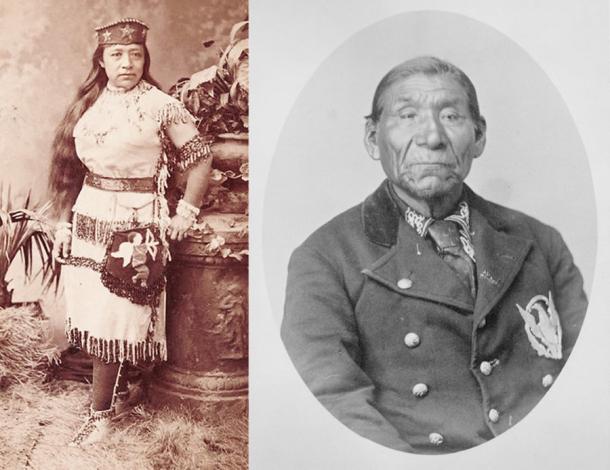
Sarah Winnemucca, Paiute writer and lecturer, on the left, and her father Chief Poito Winnemucca of the Paiute Natives in Nevada. (Public domain / Public domain)
The Paiute Legend of the Lovelock Giants and their Massacre at Lovelock Cave
Si-Te-Cah or Saiduka literally translates as “tule-eaters” in the Northern Paiute language. The tule is a fibrous water plant, which according to legend, was woven by giants into rafts in order to escape attacks by the Paiute. They used the rafts to navigate across what remained then of Lake Lahontan, an ancient lake that once covered most of northern Nevada during the last ice age.
- Ancient Giants of the Americas: Suppressed Evidence and the Hidden History of a Lost Race
- Ancient Race of White Giants Described in Native Legends From Many Tribes
As the Paiute tale goes, after years of warfare, all the tribes in the area joined together to rid themselves of the Si-Te-Cah. One day, as the tribes chased down the last remaining red-haired giants, they took refuge in a cave. The Paiutes demanded their enemy come out of the cave and fight, but the giants refused.
The coalition of tribes proceeded to shoot arrows at them while starting a large fire at the mouth of the cave. The smoke drove out a few who died in a hail of arrows while the rest were all either burned alive or asphyxiated. Over time, the entrance to the cave would collapse leaving it accessible only to bats and cut off from human contact.
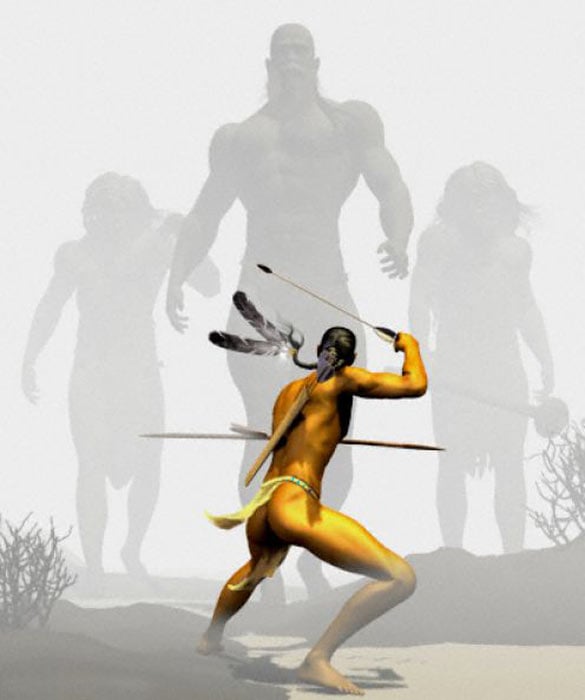
According to Northern Paiute legend, the Si-Te-Cah were red-haired giants. (Biblioteca Pleyades / CC BY-NC-ND 3.0)
Lovelock Cave in Nevada
Lovelock Cave, known also as Bat Cave, Horseshoe Cave, Sunset Guano Cave and Indian Cave is located 20 miles south of modern day Lovelock, Nevada. It’s a very old cave that pre-dates humans on the continent and in prehistoric times was underneath Lake Lahontan.
In 1886, a mining engineer from Lovelock named John T. Reid was told of the legend by local Indians, who took him to the site to prove it existed. Reid was unsuccessful in getting an archeological dig started immediately, but two miners, James Hart and David Pugh, realized the value of guano as an ingredient of gunpowder, and created a company to start digging it out in 1911.
They stripped a layer of guano from the cave approximately three to six feet deep, using a pick and shovel with little regard to the artifacts, and shipped some 250 tons of it to the Hawaiian Fertilizer Company in San Francisco.
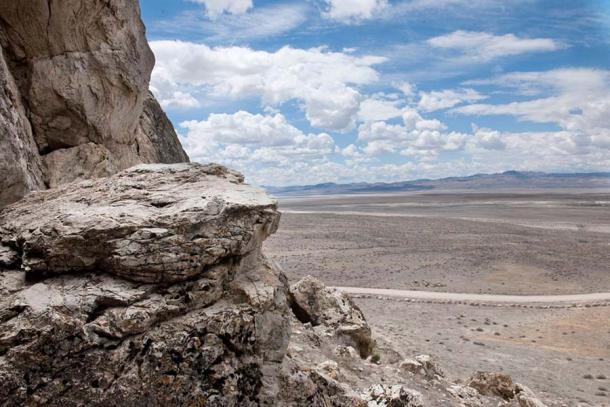
Location of Lovelock Cave in Nevada. (Public domain)
Archaeological Explorations at Lovelock Cave
Alfred Kroeber, founder of the University of California Anthropology Department was contacted by Hart and Pugh when they reported finding prehistoric artifacts. This spurred the first archeological dig of Lovelock in 1912 led by L. L. Loud also of the University of California.
A second dig took place in 1924 and after finishing the excavations, Loud collaborated on a report that was published in 1929. What Loud found was nothing short of amazing. Approximately 10,000 archaeological specimens were uncovered including tools, bones, baskets, and weapons.
According to the report, 60 average-height mummies were unearthed. Duck decoys (among the oldest known in the world with feathers still attached) and a sandal over 15 inches (38 cm) long were excavated. A donut-shaped stone with 365 notches carved along the outside and 52 corresponding notches inside was found, which some scientists believe is a calendar.
Interestingly, radiocarbon dating done on follow up visits found vegetable material dating back to 2030 BC, a human femur dating to 1450 BC, human muscle tissue dating 1420 BC, and basketry dating back to 1218 BC.
Archaeologists concluded from this that human occupation of Lovelock cave, by this culture, started in 1500 BC. Today's anthropologists call the people who lived in the area the Lovelock Culture with the Period lasting some 3,000 years. Many archaeologists believe that the Lovelock Culture was replaced by Northern Paiutes.

Entrance to Lovelock Cave in Nevada. (Ken Lund / CC BY-SA 2.0)
Exploring the Lovelock Giants and their Remains
There is some debate as to the veracity of the claims made regarding the Lovelock Giants. During the initial excavations, there were reports of mummified remains being found of two red-haired giants. One was a female 6.5-feet (1.98 m) tall and the other a male over 8-feet (2.44 m) tall. However, no such evidence remains.
In Sarah Winnemucca Hopkins book, Life Among the Piutes: Their Wrongs and Claims, she does not mention giants, but does refer to so-called barbarians. Skeptics claim that chemical staining by earth after burial was a likely reason why mummified remains have red hair instead of black, like most Indians in the area. A study done at the University of Nevada indicates the “giants” were about six feet (1.83 m) tall, and not up to 8 feet (2.44 m) tall as had been claimed.
To others, the uncovering of 15” sandals (38.1 cm) at Lovelock Cave is proof enough that the Paiute tale is real. In an article published in the Nevada Review-Miner in 1931, in February and June of that same year, it was reported that two very large skeletons were found in the Humboldt dry lake bed near Lovelock, Nevada.
One of the Lovelock skeletons was reported to have measured 8.5-feet (2,59 m) tall and was later described as having been wrapped in a gum-covered fabric similar to Egyptian mummies. The other was supposedly nearly 10-feet (3.05 m) long.
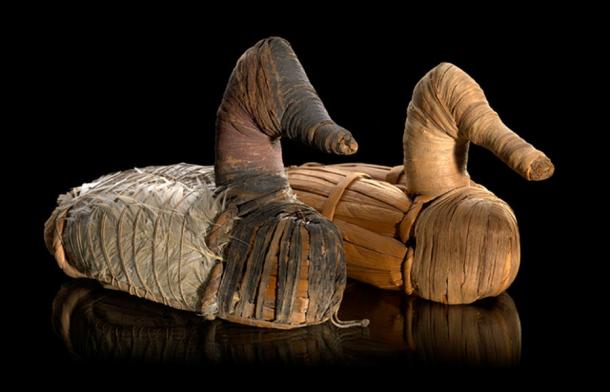
Duck decoys found in Lovelock Cave from circa 400 BC to 100 AD, now on display at the National Museum of the American Indian. (Smithsonian)
Linking the Giants of Lovelock Cave with the Uros Indians of South America
Some other evidence for the Lovelock Giants includes a set of images showing a handprint, more than double the size of a normal man’s hand imprinted on a stone bolder in the cave which was released by Bigfoot investigators MK Davis and Don Monroe in 2013.
Along the Peru/Bolivia border skulls have been found near Lake Titicaca, with claims being made they were from giants with reddish hair and elongated skulls. The legends tell of the Uros Indians making reed boats and living on islands on Lake Titicaca similar to the Paiute. The Incas apparently drove them to live this way much like the Paiutes’ ancestors apparently did to the giants at Lake Lahontan.
Today, many of the original artifacts found at Lovelock (but no giants) can be viewed at a small natural history museum located in Winnemucca, Nevada. Objects such as the duck decoys are housed at the Smithsonian Museum in Washington D.C., and the basketry and bones belong to the Nevada State Museum.
The site is significant in an archaeological context because it is an example of a legend being confirmed by archaeological evidence, in this case legends which the Paiutes elders had been telling their tribal children for years.
In fact, the Phoebe A. Hearst Museum of Anthropology at the University of California published a paper on Lovelock cave in 2005 had this to say: “The site has been extensively pot-hunted and many materials remain in private collections. Lovelock Cave, despite years of destruction, is one of the most important sites in the history of North American archaeology.” Lovelock Cave was officially designated a historical site in 1984.
Top image: Interior of Lovelock Cave located next to the former lakebed of Lake Lahontan in Nevada. Source: BLM Nevada / CC BY-SA 2.0
By Bryan Hilliard
References
Dover, D. 2014. "Paiutes Battle Red Haired Giants at Lovelock Cave" in Bigfoot Junction. Available at: http://sasquatchresearchers.org/blogs/bigfootjunction/2015/01/19/paiutes-battle-red-haired-giants-at-lovelock-cave/
Dunning, Brian. 26 November 2013. "The Red Haired Giants of Lovelock Cave” in Skeptoid. Available at: http://skeptoid.com/episodes/4390
Lesley, C. L. 12 December 2011. "Giant Sandals from Lovelock” in Greater Ancestors. Available at: http://greaterancestors.com/giant-sandals-from-lovelock/
Matthews, D. 29 July 2013. "Has An Ancient Giant Handprint Been Found In A Cave In Nevada?" in The Truth. Available at: http://thetruthwins.com/archives/has-an-ancient-giant-handprint-been-found-in-a-cave-in-nevada
Morehead, R. 2 August 2014. "Lovelock Cave" in Ron Morehead. Available at: http://ronmorehead.com/lovelock-cave/
No name. No date. “L.L. Loud and the Beginning of Nevada Archaeology” in Online Nevada Encyclopedia. Available at: http://www.onlinenevada.org/articles/ll-loud-and-beginning-nevada-archaeology
No name. No date. “Great Basin Prehistoric Footwear” in Online Nevada Encyclopedia. Available at: http://www.onlinenevada.org/articles/great-basin-prehistoric-footwear.
Riley, B. 1976. "Seek to Clarify Indian Myth about Tribe of Cannibal Giants" in YesterYear Once More. Available at: https://yesteryearsnews.wordpress.com/2012/04/02/sarah-winnemucca-an-indian-princess/
Snyder, M. 16 January 2014. "These Ancient Elongated Skulls Are NOT HUMAN" in The Truth. Available at: http://thetruthwins.com/archives/these-ancient-elongated-skulls-are-not-human
















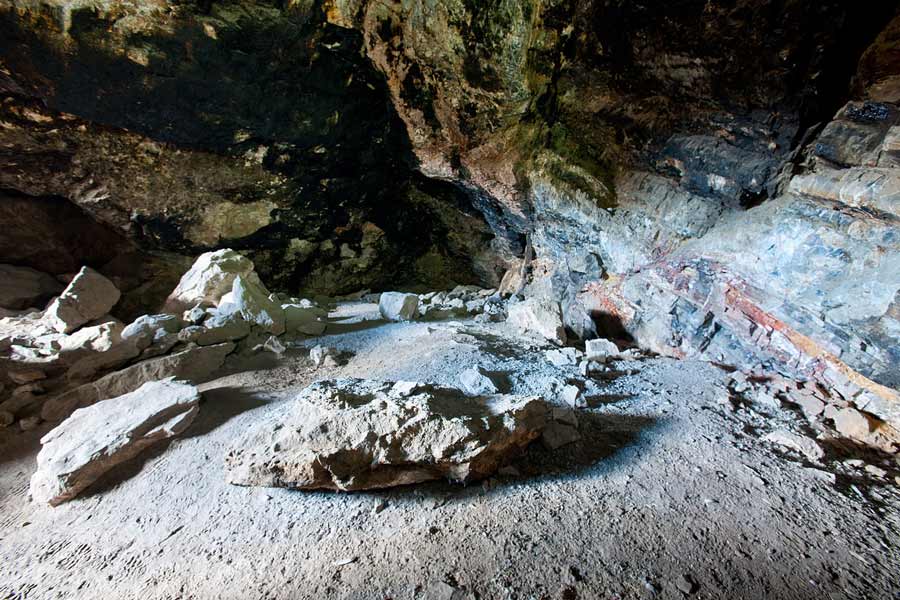

Comments
Terrestrial Evolution Supporting Planetary Motion
Many observations and the latest technologies, new telescopes and measuring techniques, advance math’s and physics are all used to help model our solar system, galaxy and Universe. Theories and models exist that describe how our planets within our solar system have formed and change. Different theories and models exist and it is suggested here that our planets recorded changes in evolution is evidence that provides a logical suggestion of planetary motion.
The motion of Earth considered is the movement towards the sun producing the changing environmental conditions resulting in our evolutionary changes. This motion also explains logically, data that has been recorded in ancient fossil records. Ancient coral rings indicate that a year once had 420 days per year around the Jurassic period. Terrestrial evolution theories define that our once naked planet sprang into life due to its position within the Goldilocks zone. This is the zone where water is stable, too close to the sun and it evaporates and too far away it is frozen. Life grew, changed and flourished and finally produced plants and animals that reached a maximum size when large dinosaurs roamed our planet. Since this time species have been getting smaller and smaller especially seen during the late Pleistocene period where many larger species have reduced in size to smaller species.
The current model for planetary motion suggest that Earth has not changed its distance from the sun and that 420 days per year has occurred because the Earth is slowing down in its rotation. If this is so, then a year would have been the same length but each day would have been much shorter or faster. Now logic suggests that these large dinosaurs would not suit a faster day. They were large and cumbersome and the complete opposite change would be logical. Now we are also aware that creatures have been losing hair suggesting warmer environmental conditions as global warming suggests today.
Let’s consider the possibility now that the Earth is moving closer to the sun. If a revolution was once longer as the radius from the sun was once greater then this would also result in a year having more days. Considering the past 500 million years if the Earth moves fractionally and constantly towards the sun then progressive environmental changes would result. Proportional to a decreasing radius the number of days in a revolution or year would decrease as indicated by the evidence. Likewise, as the distance to the sun decreases a temperature increase would also occur. This basic motion produces simple environmental changes that supports directly the changes in evolution. Hair has been progressively shed as temperature increases. Days and years progressively decrease at first allowing life to spring and evolve, developing and evolving to a point in time or planetary position, where maximum size was established. Continuing along this path both years and days become shorter and smaller as with the adaption of species, more refined, smaller also adapting to the warmer conditions.
Mercury 1 Venus 1 Earth 365 Mars 670 Jupiter 10504 Saturn 25292
If you could sit on each of our planets this is the number of days, you would experience in a year or revolution. A very simple pattern can be seen. By placing a 420-day year into this sequence it appears logical as to the distance and position Earth would have been located at this point in history.
For a mathematical and physics theory that supports this motion by C. Johan Masreliez please visit;
http://citeseerx.ist.psu.edu/viewdoc/download?doi=10.1.1.68.3879&rep=rep...
The consideration of this planetary life-cycle and awareness allows a fuller picture of evolution to become logical. The major aspect here is the movement through the goldilocks zone where water allows the phase of expression of life on Earth at a given moment to be manifested. The Earth has relatively recently passed through the mid-point of the goldilocks zone where water is at a maximum level. Allowing for the changes in time and environmental conditions as a planet gets closer to the sun our exact position in time can be determined. Years before the mid-point are progressively longer and become progressively shorter after this mid-point.
Hi All,
I suppose in this case People who've lived in America before Columbus are going too know what lives in their backyard, front yard, and Center.
My argument regarding this Subject of The Red Headed White Giant's is a precise detail considering Columbus didn't land in The New World till 1492.
The People living in America before Columbus an all European colonies know who they share their Ancestral homeland with the Supreme skepticism towards The Nevada Tribe is what ticks me all of The People from this Nevada Tribe still being dismissed as poor people don't even understand what they were seeing.
I don't know The Pawnees knew what they were talking about when observing Race of fast giant's so powerful they could run beside a Buffalo pick it up hold it under it's arm and rip one leg off and begin eating it like it's a turkey leg or something.
That oral account left me wondering how big were those giants considering a how large a Buffalo stands.
Ironically giant's is a Universal Word much like Dragon's & Monster's All of the people here in Mesoamerica has stories of dragon's as well it's almost a side-by-side word right next too the giant's still an those stories are dismissed as untrue.
I guess this is all I have to share on this discussion about the giant's so I'll check in some other time on another Subject, until next discussiob everyone, Goodbye!
Hi All,
I suppose in this case People who've lived in America before Columbus are going too know what lives in their backyard, front yard, and Center.
My argument regarding this Subject of The Red Headed White Giant's is a precise detail considering Columbus didn't land in The New World till 1492.
The People living in America before Columbus an all European colonies know who they share their Ancestral homeland with the Supreme skepticism towards The Nevada Tribe is what ticks me all of The People from this Nevada Tribe still being dismissed as poor people don't even understand what they were seeing.
I don't know The Pawnees knew what they were talking about when observing Race of fast giant's so powerful they could run beside a Buffalo pick it up hold it under it's arm and rip one leg off and begin eating it like it's a turkey leg or something.
That oral account left me wondering how big were those giants considering a how large a Buffalo stands.
Ironically giant's is a Universal Word much like Dragon's & Monster's All of the people here in Mesoamerica has stories of dragon's as well it's almost a side-by-side word right next too the giant's still an those stories are dismissed as untrue.
I guess this is all I have to share on this discussion about the giant's so I'll check in some other time on another Subject, until next discussiob everyone, Goodbye!
These red-haired, white giants are more like nephilim, and are not the same as Sasquatch, who are actually much older, and were here way before us.
tamifabulous
I have been shown why animal sizes, including larger human species have evolved and changed. The reason is correlated to the evolutionary process of the World structure and formation.
I have been studying the movement of the planets theories. This is looking at data and evidence especially the evolutionary process with respect to the movement or life-cycles of the planets. Ultimately this is reviewing the planets rotation and revolution relative to the distance from the sun. This deduces a natural pattern or life-cycle, organic process for the natural movement and formation of the planets.
With regards to the position of Earth relative to the sun, there are only a few options to consider. The first is the Earth has always been at the same distance from the sun. This is difficult to imagine considering it's formation. Next the Earth is moving away from the sun, but as the planets didn't evolve from the sun considering vast periods of time, especially for the closest planets to the sun, then this suggests, additional movements. Last the Earth is moving slowly towards the sun. Another option is that it is a combination of both movements, towards and away, so what could change a planets direction?
To consider these options it is easier when imagining endless and vast amounts of time, speeding up the process into seconds. Very briefly if we look at the options over vast amounts of time we can determine the likelihood of our options. We can then review the evidence supporting the options. This is very important for the data produced by the fossil coral counts indicating a 420 day year at approximately 420 million years ago.
Have all of the planets randomly gathered about our sun in their perfect distances and spacings and are they all moving away from the sun, perhaps moving in different directions?The planets can't be forged from the sun so if they are moving away from the sun how long has this been happening?
It is theorised that a much more natural organic process is also possible. Around the luring of thousands of suns, scattered through thousands of Galaxies, the luring of these burning balls provide an opportunity where cosmic dust and rocks or simple smaller collisions are drawn together and begin a process moving towards the burning luring mass. We are going to look at this simple process of which the Earth and our other planets are in a natural progressive cycle, through phases moving towards the sun.
If you analise the coral data assuming Earth is at the same distance from the sun, then a year would be the same revolution but at 420 days, each day would be 20 hours and 51 minutes.
This is a difference of 3 hours and 9 minutes. Now digital time suggests the Earth's rotation is slowing at a rate of 2 milliseconds per hundred years. This is one second for 500,000 years. If this rate is constant then for 3 hrs and 9 minutes or 11,340 seconds it would take the Earth 56.7 billion years to change this period of time. As these figures don't work alternative factors must be involved.
Alternatively. Each of our planets have rotation numbers relative to the distance from the sun. The smallest number of rotations and smallest revolution are closest to the sun and they get larger in number the further from the sun. Here are the number of days each planet has on each planet;
Mercury 1 Venus 1 Earth 365 Mars 670 Jupiter 10504 Saturn 25292
Logic suggest by looking at these rotation numbers, that a planet with 420 days would be situated roughly a quarter of the distance closer to Mars. It is suggested that this coral is 420 million years old approximately. If this is the situation then this suggest that we move slowly towards the sun and we would expect the Earth to be in a warming motion. Although 420 days would be logical here the revolution period would also be longer so time would be longer relative to time now. Temperatures would also be cooler. When we consider our fossil records we have reconstructed a situation where animals are hairier and fatter better suited to cooler temperatures. This can be seen through the animals that have become smaller and adapted to warmer temperatures as close as 10,000 years ago. Considering a larger time shift, our dinosaurs are also larger directly connected to the shift in time and environmental conditions, longer days and longer years.
When studying dinosaur records you can see how distinguishing features from different regions around the globe are still apparent today in the smaller life forms and also move through the recent extinct larger animals. It appears the link between the evolutionary cycle of the Earth moving closer and faster towards the sun is compressing the evolutionary expression of life on Earth, over vast periods of time.
Pages